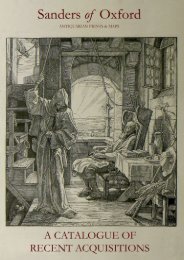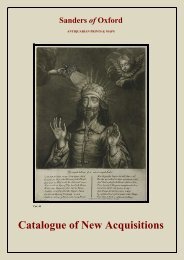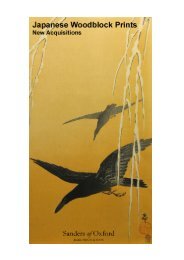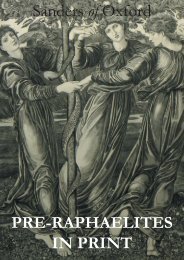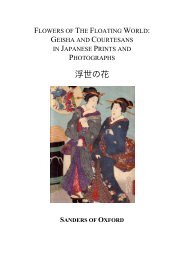Surimono catalogue FINAL WEB.pdf - Sanders of Oxford
Surimono catalogue FINAL WEB.pdf - Sanders of Oxford
Surimono catalogue FINAL WEB.pdf - Sanders of Oxford
Create successful ePaper yourself
Turn your PDF publications into a flip-book with our unique Google optimized e-Paper software.
Harukawa Goshichi was born in Edo and in 1818 he moved to Kyoto. At the beginnning <strong>of</strong> his<br />
career he drew and published portraits <strong>of</strong> actors as well as surimono. Goshichi also wrote and<br />
illustrated his own novels. He was possibly a pupil <strong>of</strong> Harukawa Eizan, from whom he took his<br />
name.<br />
Kikugawa Hidemaro (fl. 1804-1817)<br />
Hidemaro Kitagawa was a pupil <strong>of</strong> Utamaro. During Utamaro’s last years he was active in<br />
assisting his master in book illustrations.<br />
Utagawa Hiroshige (1797-1858)<br />
Utagawa Hiroshige was born in Edo, the son <strong>of</strong> a supervisor <strong>of</strong> a brigade <strong>of</strong> firemen. He studied<br />
painting with a neighbour, Okajima Rinsai, and 1811, at the age <strong>of</strong> fourteen, he began to study with<br />
the ukiyo-e artist Toyohiro. In 1814 his first print was published, but it was not unitl 1818 that he<br />
produced prints in any number. In about 1821, he produced his first square surimono and during<br />
the next decade he designed over two dozen more – a small number compared to the many<br />
thousands <strong>of</strong> commerical prints.<br />
Totoya Hokkei (1780-1850)<br />
One <strong>of</strong> Hokusai’s earliest and most gifted pupils, Hokkei was particularly renowned in the field <strong>of</strong><br />
surimono. Before his initial training with Kanô Yôsen’ in Korenobu, he worked as a fishmonger<br />
at Yotsuya Samegahashi, hence the unusual art surname <strong>of</strong> Totoya/Uoya (fish shop). Hokkei’s<br />
first work appeared in 1799. He designed a number <strong>of</strong> surimono in the 1800s and 1810s, but he<br />
did not master the art <strong>of</strong> desiging them until the late 1810s. Besides surimono and illustrations<br />
for poetry albums, Hokkei designed a few illustrations for popular fiction and some commercially<br />
published prints.<br />
Teisai Hokuba (1771-1844)<br />
Teisai Hokuba was an inactive retainer <strong>of</strong> the shogun: later in his life he too lay religious orders.<br />
He was active in the 1800s and 1810 as an illustrator <strong>of</strong> popular fiction, but also designed a<br />
few surimono during this period and continued to design illustrations for privately printed poetry<br />
anthologies thereafter. He may have been one <strong>of</strong> Hokusai’s earliest pupiles and adopted the<br />
name Hokuba while Hokusai was still using the name Sori.<br />
Katsushika Hokusai (1760-1849)<br />
Hokusai began his career as a print designer in 1779 as a pupil <strong>of</strong> Katsukawa Shunso. Hokusai<br />
appears to have become intrigued by the surimono in the 1790s. Fumiko Togasaki, in her 1979<br />
essay on Hokusai’s surimono, suggests that this was related to the Kansei Reforms <strong>of</strong> 1790, which<br />
attempted to control morals and manners as well as publications, including woodblock prints. Each<br />
print was required to have the <strong>of</strong>ficial approval <strong>of</strong> the Tokugawa government, and from this year<br />
on a censor mark appeared on every print. <strong>Surimono</strong> needed neither publisher nor government<br />
approval, because it was privately printed at the patron’s own expense.<br />
In 1796, Hokusai designed a number <strong>of</strong> surimono and privately published album sheets. From<br />
1799 to 1809, he produced a large number <strong>of</strong> surimono prints, but relatively few in the following<br />
decade. In 1820 Hokusai resumed designing surimono and produced a large number in the two




